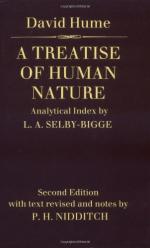This principle being once admitted, all the other doctrines of that philosophy seem to follow by an easy consequence. For upon the removal of sounds, colours, beat, cold, and other sensible qualities, from the rank of continued independent existences, we are reduced merely to what are called primary qualities, as the only real ones, of which we have any adequate notion. These primary qualities are extension and solidity, with their different mixtures and modifications; figure, motion, gravity, and cohesion. The generation, encrease, decay, and corruption of animals and vegetables, are nothing but changes of figure and motion; as also the operations of all bodies on each other; of fire, of light, water, air, earth, and of all the elements and powers of nature. One figure and motion produces another figure and motion; nor does there remain in. the material universe any other principle, either active or passive, of which we can form the most distant idea.
I believe many objections might be made to this system But at present I shall confine myself to one, which is in my opinion very decisive. I assert, that instead of explaining the operations of external objects by its means, we utterly annihilate all these objects, and reduce ourselves to the opinions of the most extravagant scepticism concerning them. If colours, sounds, tastes, and smells be merely perceptions, nothing we can conceive is possest of a real, continued, and independent existence; not even motion, extension and solidity, which are the primary qualities chiefly insisted on.
To begin with the examination of motion; it is evident this is a quality altogether inconceivable alone, and without a reference to some other object. The idea of motion necessarily supposes that of a body moving. Now what is our idea of the moving body, without which motion is incomprehensible? It must resolve itself into the idea of extension or of solidity; and consequently the reality of motion depends upon that of these other qualities.
This opinion, which is universally acknowledged concerning motion, I have proved to be true with regard to extension; and have shewn that it is impossible to conceive extension, but as composed of parts, endowed with colour or solidity. The idea of extension is a compound idea; but as it is not compounded of an infinite number of parts or inferior ideas, it must at last resolve itself into such as are perfectly simple and indivisible. These simple and indivisible parts, not being ideas of extension, must be non entities, unless conceived as coloured or solid. Colour is excluded from any real existence. The reality, therefore, of our idea of extension depends upon the reality of that of solidity, nor can the former be just while the latter is chimerical. Let us, then, lend our attention to the examination of the idea of solidity.




